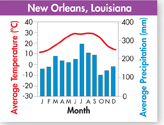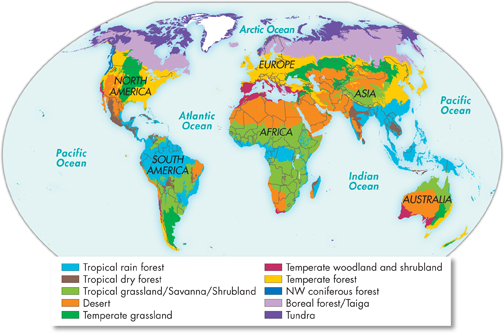Defining Biomes Ecologists classify Earth's terrestrial ecosystems into at least ten different groups of regional climate communities called biomes.  Biomes are described in terms of abiotic factors like climate and soil type, and biotic factors like plant and animal life. Major biomes include tropical rain forest, tropical dry forest, tropical grassland/savanna/shrubland, desert, temperate grassland, temperate woodland and shrubland, temperate forest, northwestern coniferous forest, boreal forest/taiga, and tundra. Each biome is associated with seasonal patterns of temperature and precipitation that can be summarized in a graph called a climate diagram, like the one in Figure 4–17. Organisms within each biome can be characterized by adaptations that enable them to live and reproduce successfully in the environment. The pages that follow discuss these adaptations and describe each biome's climate.
Biomes are described in terms of abiotic factors like climate and soil type, and biotic factors like plant and animal life. Major biomes include tropical rain forest, tropical dry forest, tropical grassland/savanna/shrubland, desert, temperate grassland, temperate woodland and shrubland, temperate forest, northwestern coniferous forest, boreal forest/taiga, and tundra. Each biome is associated with seasonal patterns of temperature and precipitation that can be summarized in a graph called a climate diagram, like the one in Figure 4–17. Organisms within each biome can be characterized by adaptations that enable them to live and reproduce successfully in the environment. The pages that follow discuss these adaptations and describe each biome's climate.
The distribution of major biomes is shown in Figure 4–18. Note that even within a defined biome, there is often considerable variation among plant and animal communities. These variations can be caused by differences in exposure, elevation, or local soil conditions. Local conditions also can change over time because of human activity or because of the community interactions described in this chapter and the next.
 In Your Notebook On the biome map in Figure 4 –18, locate the place where you live. Which biome do you live in? Do your climate and environment seem to match the description of the biome on the following pages?
In Your Notebook On the biome map in Figure 4 –18, locate the place where you live. Which biome do you live in? Do your climate and environment seem to match the description of the biome on the following pages?

FIGURE 4–17 Climate Diagram A climate diagram shows the average temperature and precipitation at a given location during each month of the year. In this graph, and those to follow, temperature is plotted as a red line, and precipitation is shown as vertical blue bars.
dVISUAL SUMMARY
BIOMES

FIGURE 4–18 This map shows the locations of the world's major biomes. Each biome has a characteristic climate and community of organisms.
dTable of Contents
- Formulas and Equations
- Applying Formulas and Equations
- Mean, Median, and Mode
- Estimation
- Using Measurements in Calculations
- Effects of Measurement Errors
- Accuracy
- Precision
- Comparing Accuracy and Precision
- Significant Figures
- Calculating With Significant Figures
- Scientific Notation
- Calculating With Scientific Notation
- Dimensional Analysis
- Applying Dimensional Analysis




